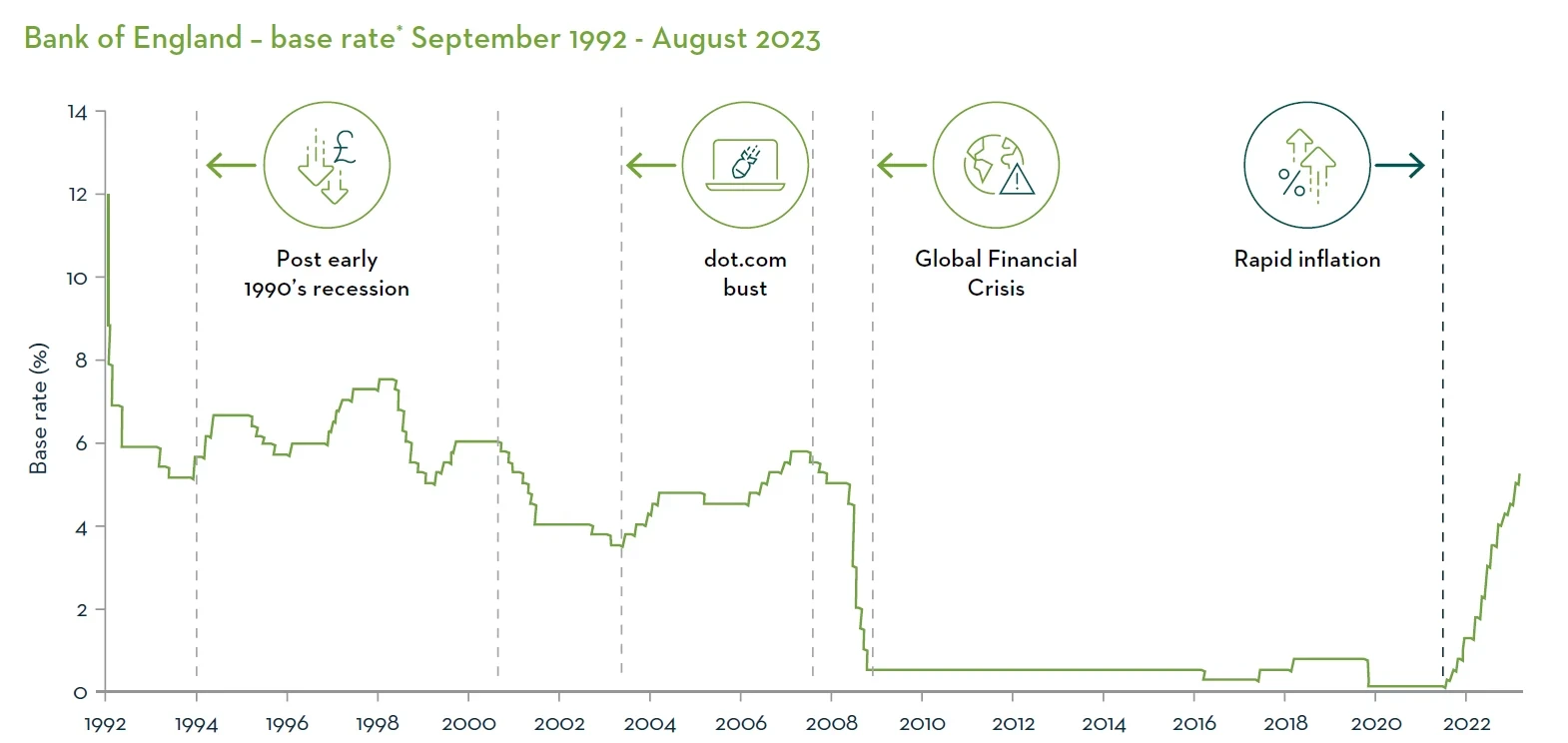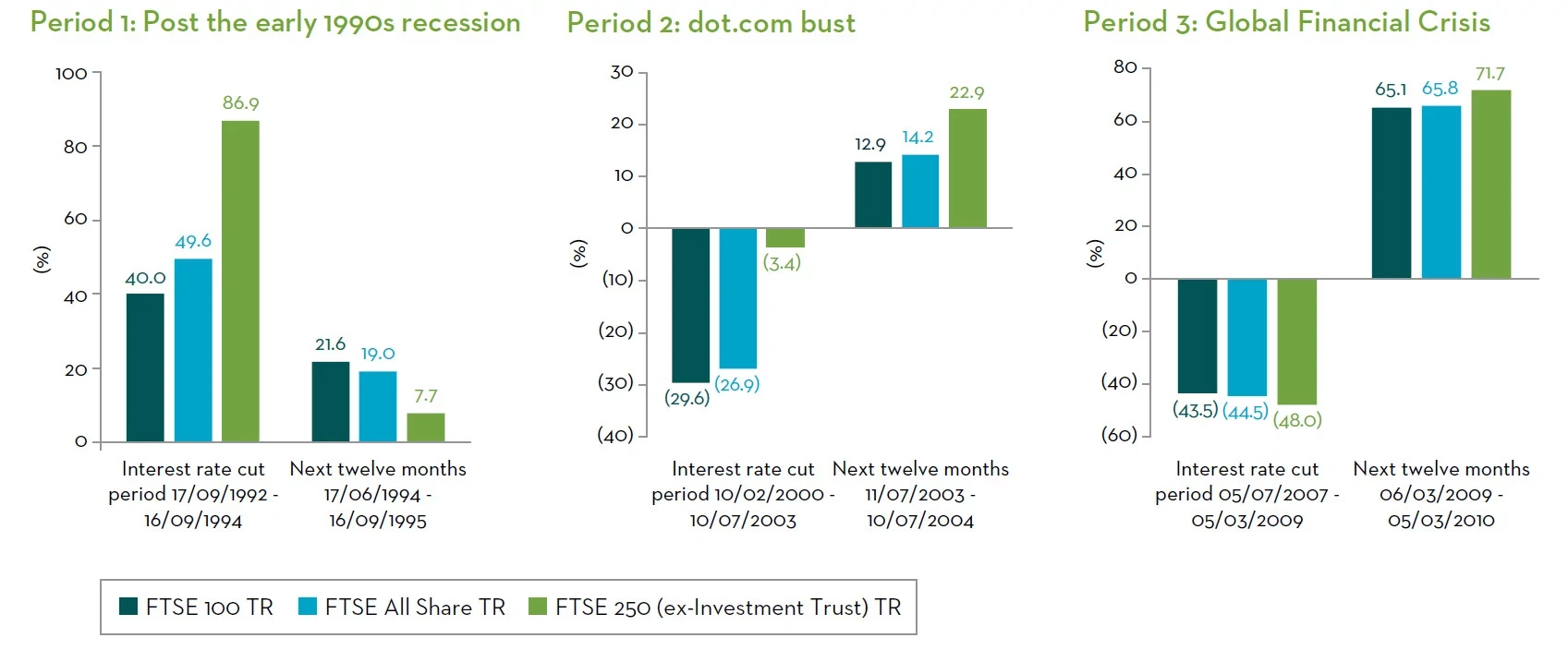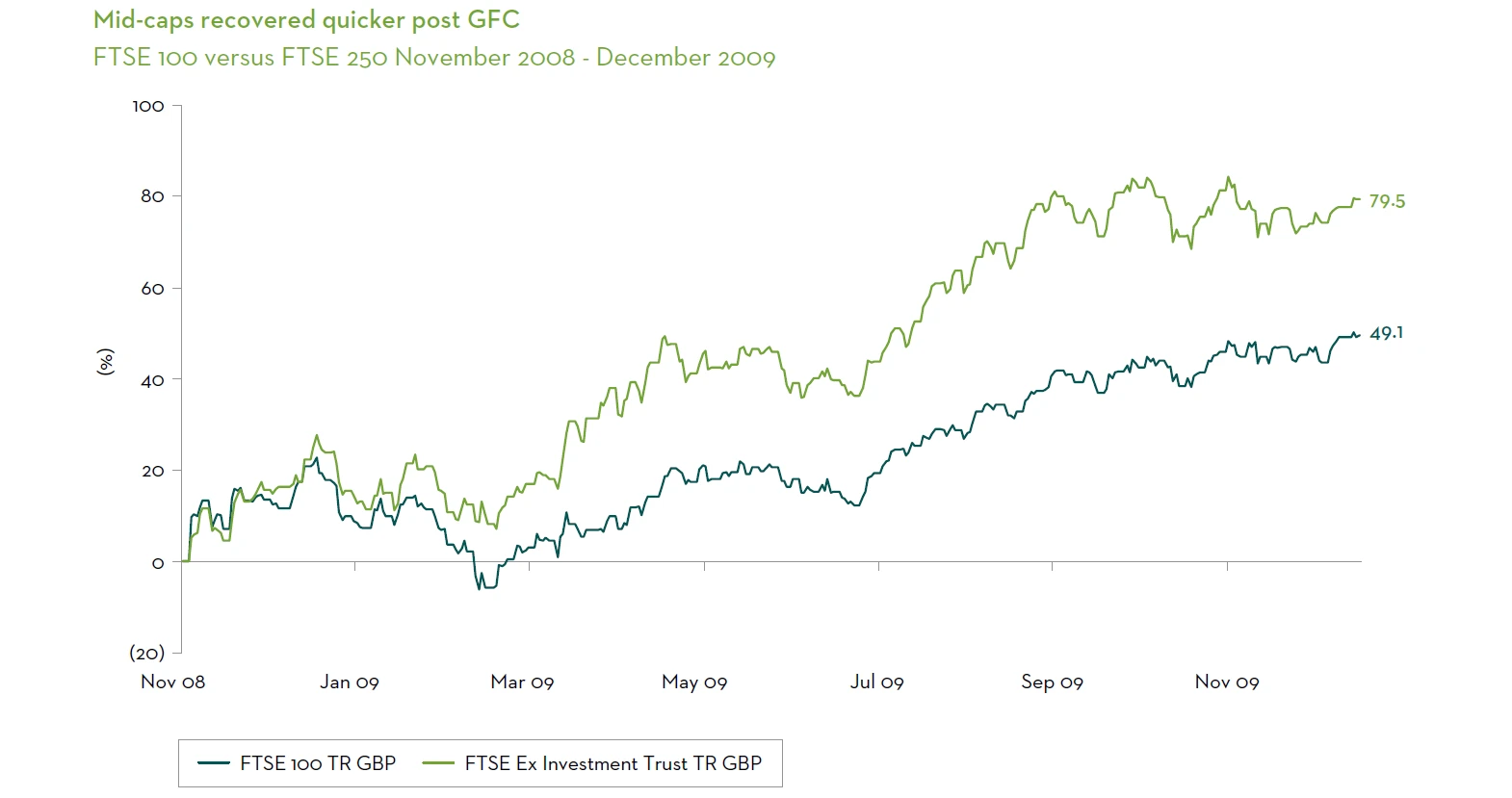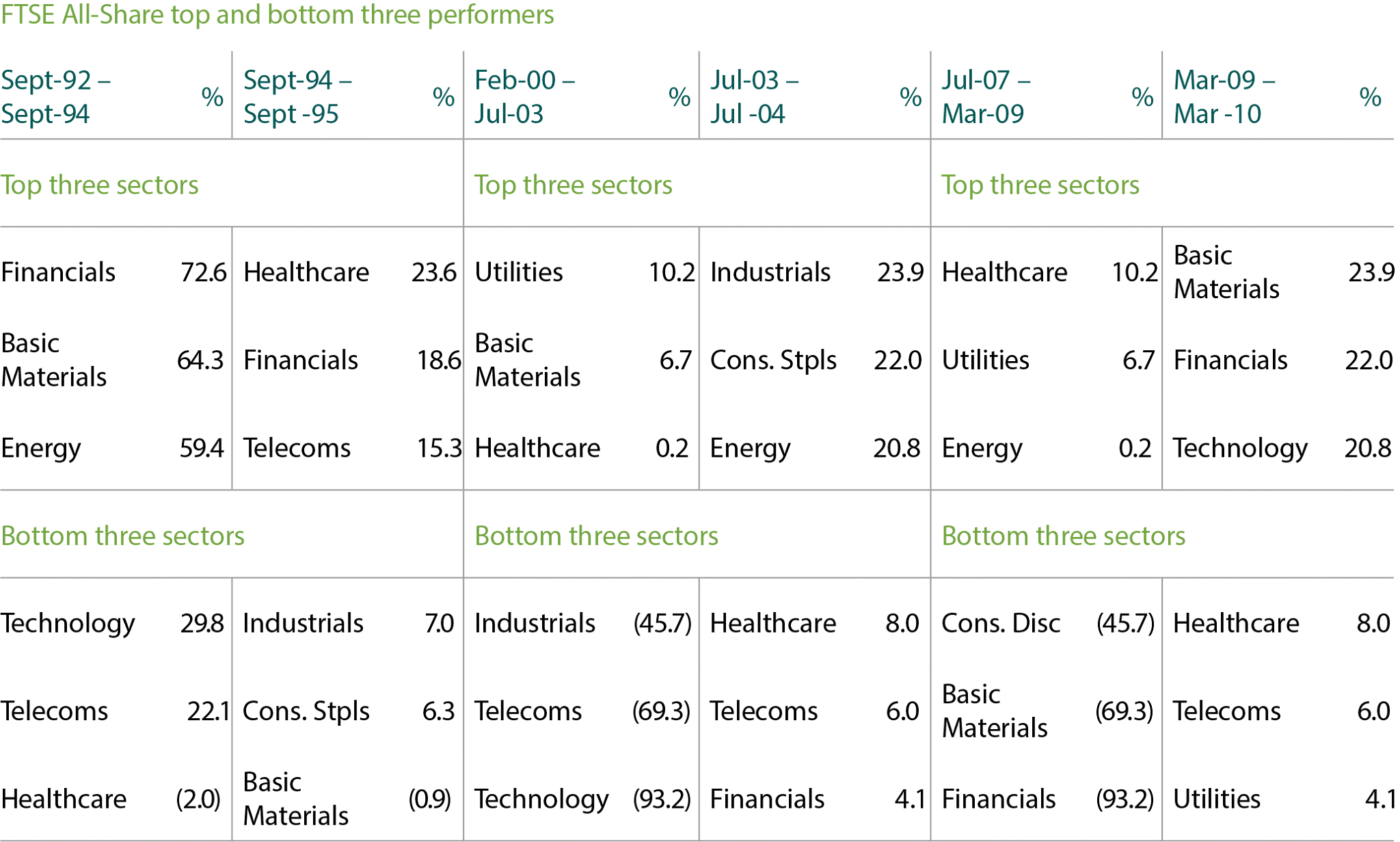25 Apr 2024
With history set to repeat itself, why now is the time for UK mid-caps. Martin Currie's Chief Investment Officer, Michael Browne, puts the spotlight on falling interest rates and what could happen to mid-caps when rates fall.
CONTRIBUTORS | Michael Browne, Chief Investment Officer Martin Currie
The underlying feeling in the equity markets is that good news is coming. The inverted yield curve was right in forecasting a recession, even if it was much milder than the BoE’s Monetary Policy Committee (MPC) prediction1. We are on the cusp of falling interest rates again as central banks await the data that will allow them to start what looks like a long descent.
Equity markets appear excited by both the prospect of rate cuts and of a much better backdrop in 2025.
So, what next? What has happened when the MPC cuts rates? It doesn’t happen often, but we looked at the rate cutting cycles of 1992-94, 2000-03 and 2007-09 for guidance and if this feels from a long time ago, it was! Such was the legacy of the Global Financial Crisis (GFC).

Source: Bank of England, December 2023. *Repo Rate (1994 – 2005) and Official Bank Rate (2006 – date) are interest rates. The Minimum Band 1 Dealing Rate are discount rates (1992-1994). 16.9.92, UK leaves the European Exchange Rate Mechanism. Base rate was raised to 12% and planned to be 15% (with effect from 17.9.92; never implemented).
In 1992-94 equities rose with the FTSE All Share rising a phenomenal 49%.
This was in sharp contrast to their performance since the Millenium. During the rate cut periods, they fell 27% in the dot.com bubble of 2000-03 and dropped 44% in the GFC2.
Underneath the FTSE All Share there are some surprises.
In 1992-94 whilst every part of the index rallied, the FTSE 100 was the worst performer, with the total return of 40%. But the FTSE 250 (ex-Investment Trusts)3 rose an astonishing 87%. Halcyon days.

Source: Morningstar over periods shown. Performance of FTSE 100, FTSE All-Share and FTSE 250 (ex-Investment Trust) shown. Performance in £. Past performance is not a guide to future returns. The return may increase or decrease as a result of currency fluctuations.
But what of returns in the negative post-Millenium period? In 2000-03 the FTSE 100 total return was a horrible -30%, however the FTSE 250 outperformed, down a “mere” 3%. This was the markets’ “Fright Night”.
The GFC saw further losses as rates were cut, markets fell and the FTSE 100 was down 43%. The FTSE 250 was worst affected down 48% over the whole period. But, this doesn’t show the whole picture4. If we look at the chart below, the FTSE 250 recovered earlier, hitting the market low in November 2008, and recovering quicker than FTSE 100 in the subsequent 12 months.
So, in periods of economic stress, we believe it is time to start looking at UK mid-caps.

Source: Morningstar. Returns shown from 21 November 2008, this was the market low for the FTSE 250 following the GFC. Performance of FTSE 100 and FTSE 250 (ex-Investment Trust) shown. Performance in £. Past performance is not a guide to future returns. The return may increase or decrease as a result of currency fluctuations.
After the dust settles, what is next?
What happened in the year after these rate cuts had ended? UK equities made positive returns. The post GFC wild ride saw increases of 60% + for all the indices, but mid-caps were once again the winner with a 71% total return.
Life was a little more sedate in 2003-04 when the FTSE 100 rose by 13%. But again the more growth orientated FTSE 250, consisting companies with greater exposure to the domestic economy was arguably better positioned into the recovery: and it returned 23%.
30 years ago, in 1994-95 is the only time when the FTSE 250 does not keep its crown despite returning a respectable 7.5%. The FTSE 100 produced its only gold medal finish, a podium topping return of 21%.
We’ve made the case that when BoE is cutting rates is the time to consider investing in UK mid-caps, but investors need to be aware of significant sector rotations and volatility.
It is during these periods of strain and volatility when active management can help. For example, in the 1992-94 period, healthcare went from worst to best in the subsequent recovery. The opposite was true for basic materials. In wake of the ‘dot.bust’, industrials went from being from one of the weakest sectors to leaders. Likewise, in the GFC, Healthcare and Utilities were relatively the strongest, but became the worst performers in the recovery, while financials and basic materials powered back to the top (please see appendix).
When economic conditions change, it can lead to a changeable market backdrop. An active approach focused on the companies themselves can capture the potential of the mid-cap space – and limit exposure to weaker performing areas to help navigate the volatility. While limiting exposure to weaker performing areas to help navigate the volatility.
Is there a sea change coming for UK Equities as we enter a period of sustained rate decreases? Mid-caps have been overlooked, so is this time to consider looking at the FTSE 250?
All change at the top

Source: Morningstar over periods shown. Performance of FTSE All-Share sectors shown. Performance in £. Past performance is not a guide to future returns. The return may increase or decrease as a result of currency fluctuations.
Endnotes
WHAT ARE THE RISKS?
All investments involve risks, including possible loss of principal. The value of investments can go down as well as up, and investors may not get back the full amount invested.
Equity securities are subject to price fluctuation and possible loss of principal.
IMPORTANT LEGAL INFORMATION
This material is intended to be of general interest only and should not be construed as individual investment advice or a recommendation or solicitation to buy, sell or hold any security or to adopt any investment strategy. It does not constitute legal or tax advice.
The views expressed are those of the investment manager and the comments, opinions and analyses are rendered as at publication date and may change without notice. The information provided in this material is not intended as a complete analysis of every material fact regarding any country, region or market. All investments involve risks, including possible loss of principal.
Data from third party sources may have been used in the preparation of this material and Franklin Templeton ("FT") has not independently verified, validated or audited such data. FT accepts no liability whatsoever for any loss arising from use of this information and reliance upon the comments opinions and analyses in the material is at the sole discretion of the user.
Products, services and information may not be available in all jurisdictions and are offered outside the U.S. by other FT affiliates and/or their distributors as local laws and regulation permits. Please consult your own financial professional or Franklin Templeton institutional contact for further information on availability of products and services in your jurisdiction.
Issued by Franklin Templeton Investment Management Limited (FTIML). Registered office: Cannon Place, 78 Cannon Street, London EC4N 6HL. FTIML is authorised and regulated by the Financial Conduct Authority.
Investments entail risks, the value of investments can go down as well as up and investors should be aware they might not get back the full value invested.
CFA® and Chartered Financial Analyst® are trademarks owned by CFA Institute.